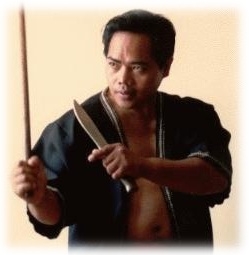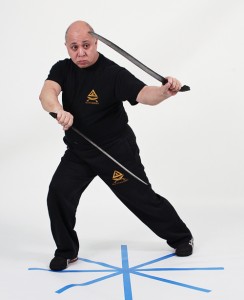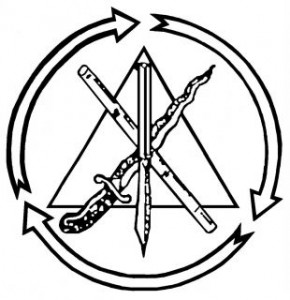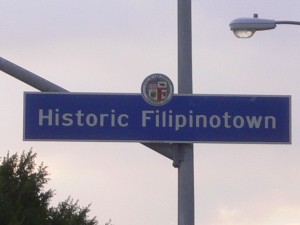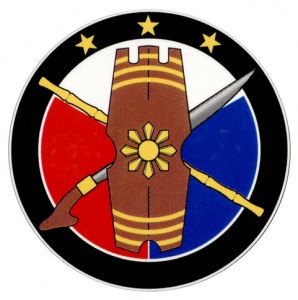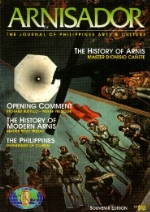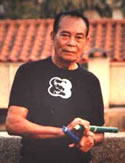
Grandmaster Antonio Ilustrisimo, Courtesy of Bakbakan International and GM Tony Diego Grandmaster Antonio Ilustrisimo (1902 - 1997) originally came from Santa Fe in Bantayan Island. He came from a family that has a very long history of martials and mystical tradition. His cousin, Floro Villabrialle, was the most famous Arnis master of Hawaii. His youngest uncle, Regino Ellustrisimo, was an Arnis master in Stockton, USA. Both men were mentioned in Dan Inosanto's book on Filipino martial arts. However, the most famous of his 4 direct paternal uncles, and the most powerful fighter of the 5 brothers (some say he has more than 7 uncles) was Melecio Ilustrisimo, one of the most famous Kali masters of the Philippines of the early 20th Century, being influential in northern Cebu - Bantayan and Bohol islands. All his forbears were expert warriors and were known to posses strange mystical powers. Grandmaster Ilustrisimo's students, fondly call him "Tatang" which means "grandfather". Tatang learnt Arnis under the tutelage of his father (Isidro Illustrisimo) and uncles (especially the famous Melecio Ilustrisimo) in the old way. There were 3 famous Eskrima families in Cebu at that time:- the Ilustrisimos, the Saavedras, and the Romos. Footwork was one of the first things he had to master. As a tiny boy, he was put on a small table and his teachers would use sticks to beat his legs. He had to learn how to avoid the blows. He was also put on 3 half coconut shells in a triangular pattern and given the same harsh treatment. This footwork is known as Tatlong Bao in the Ilustrisimo family. As a result he has mastered evasion and dodging at an early age. This is a training that Melecio Ilustrisimo himself thoroughly mastered as he was said to have nailed one foot to the ground and challenge all and sundry to defeat him. No one could, and that footwork is called "Walong Apak" (Nail Footwork) in Kalis Ilustrisimo. These skills of evasive footwork have all been mastered by Grandmaster Antonio Illustrisimo. He learnt the solo and double baston, espada daga, daga, bolo (sword), dos manos (a long stick/sword - roughly equivalent to the Samurai's sword) and various "weapons of convenience". In particular, as a speciality, Grandmaster Ilustrisimo is noted for is his expertise in bladed weapons - something which many modern Grandmasters of Arnis can not lay proper claim to since their real practical experience concentrated on the rattan sticks. (Claims by most systems that they can use swords are disputable and only partially true). This expertise as a swordman is not merely from personal experience and practice, but is the legacy of his family art of Ilustrisimo Kali which is a bladed art that stretches so far back in the family line that nobody could remember when it started. As a boy, the young Ilustrisimo had a very tough, stubborn, determined and indominatable spirit. When he heard of a far country called 'America', he decided to go there - at the age of 9 years old! When his parents would not listen to his panderings, he 'took' some family money and a machete, and again, 'took' a small rowing boat and paddled out to the sea to what he thought would be America, not realising how far America really is. He fortunately chance across a ship. The sailors aboard were surprised to see a young boy rowing out in the sea. Out of curiousity, perhaps concern as well, there approached him and asked him where he was going. "I am going to America in this boat!" was the confident answer. The sailors rocked in laughter. They somehow persuaded him to come with them. Of course, he did not get to America. But he did sail to a few ports, still not quite realising that America is still very, very far away.......... At a port, he chance on a family friend who recognised him, but not wishing to betray the high ideals of this young boy, he took him to the south as that friend was a Muslim. There the young boy grew up - strong, determined, proud and skillful in combat as ever. He was adopted into a the royal court as an adopted son of the Sultan of Sulu. (This was Hadji Butu who ascended to become HH Hadji Mohammad Jamalul Kiram II, the Sultan of Sulu) While in the South, he was priviledged to train in the the best of teachers that the royal court could have. He also trained with Pedro Cortes, another very famous master in the Mindanao region, who was used by the government to control the 'Rebelious South'. Pedro Cortes was a close friend a sparring partner of his father Isidro Ilustrisimo. Then one day, he was drinking at a beer house, he got into dispute with another man. The man drew his sword to kill Tatang, but the defty young boy beat him to the draw and, with one stroke of his own barong (Tatang's favourite type of sword), he cut off the enemy's head. The victim was left a headless man running … [Read more...]

